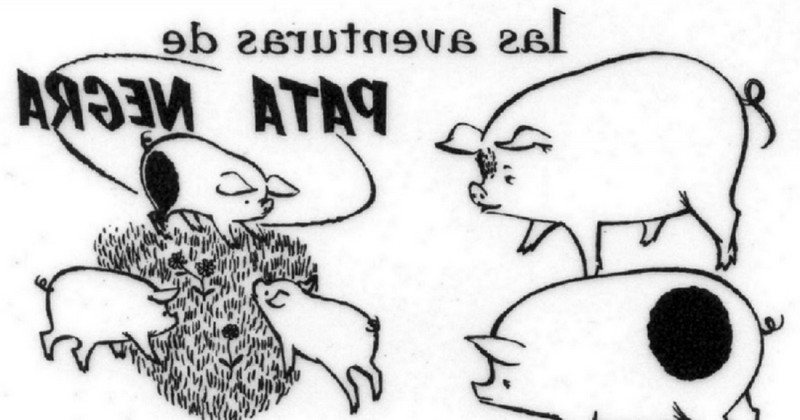Pata Negra Test: what is this projective test and how is it used?

This projective test was created by Louis Corman and is applied in child psychology and education.
In psychological assessment, projective tests consider that there are certain tendencies in people that are repressed and that project their covert mental processes thanks to a stimulation from the outside (such as a drawing).
In this article we will know the Black Paw Test, a thematic projective test, especially applicable especially in childhood, and which aims to explore the dynamic structure of the personality, as well as to define the psychic organization of the person.
Pata Negra Test: characteristics
The Pata Negra Test is a projective test (psychodynamic) of psychological evaluation, of thematic type. Thematic projective tests are characterized by having a visual material of different degree of structuring that causes different emotions and memories in the person, from which the person must elaborate a story.
The Pata Negra Test is one of the most one of the most widely used tests in the school and clinical setting to try to detect and interpret personality conflicts in children. It was developed by Louis Corman in 1979, although it is still widely used in the field of psychological assessment.
Louis Corman (1901-1995) was a French psychiatrist, considered the father of morphology.considered the father of morphopsychology. He also created the Family Test. He worked with children with different pathologies and communication difficulties.
What is it used for?
The Black Paw Test explores the dynamic structure of the personalityThe test aims to identify (if any) deep personality conflicts, especially in the early stages of life.
The test aims to identify (if present) deep personality conflicts, especially in the early stages of life.
How does it work?
The Black Leg Test is made up of 19 sheets with scenes starring little pigsamong which is the piglet "Pata Negra" (the main character).
It uses the method of free expression based on perceptual stimuli (scenes of little pigs, from which the subject must elaborate a story and/or explain what is happening).
In other words, it is a verbal thematic apperception testIt is a verbal thematic apperception test, which uses perceptual stimuli as reactive material. According to Bellack, apperception is a meaningful interpretation that an organism makes of a perception.
Preference-identification method
The Pata Negra Test also uses the method of "preferences-identifications", where the child separates the pictures he/she likes from those he/she does not like and then explains why.and then explains why; he also identifies the characters he would like to be.
All this serves to highlight relevant themes in child development according to the relevant issues in child development according to the psychoanalytic or psychodynamic orientation.. These themes are some such as orality, animality, sexuality, aggressiveness and sibling rivalry, dependence-independence, guilt, sex reversal, nurturing father and ideal mother.
Objectives
The objectives of the Black Leg Test are essentially four:
- To explore the dynamic structure of the personality.
- To identify the defense mechanisms of the self.
- To recognize the subject's instinctive tendencies.
- To define the infantile psychic organization from its conflicts, defenses and significant psychosexual dimensions.
Technical sheet
Currently there is a paper version of the Pata Negra Test, with a variable administration time (approximately one hour). The age of application is between 4 and 15 years old.preferably.
The areas in which it is applied, as we have seen, are especially in the clinical and school settings.
Types of films
The blackleg test films are divided into four types:
1. Frontispiece (first one)
The characters are presented (consists of the first sheet).
2. General plates
These are the 16 "intermediate" plates, where the adventures of the little pig Pata Negra are shown.
3. Plate 18
Shows the figure of a ladder.
4. Closing plate
A fairy is presented; The child is told that the fairy grants three wishes to Pata Negra and is asked to say what they are. and is asked to say what they are.
Advantages and disadvantages
Some of the advantages of the Black Paw Test are that it can be applied in clinical and research settings with children, adolescents and even adults. It can also be applied to psychotic adults.
As for its limitationsIn terms of its limitations, we find that it presents too many variables to be analyzed, and that sometimes its interpretation can be somewhat "subjective". In addition, all the criticisms addressed to projective tests can be attributed to it, such as the problem caused by having to interpret in a systematic way the answers given by the evaluated subject.
Bibliographical references:
- Ballús, E., Casas, M, Virgili, C. and Pérez.Testor, C. (2015). Assessment of Triangular Relationships: Development and validation of an instrument based on the projective test Pata Negra. Aloma: journal of psychology, 33(2), 87-94.
- TEA Editions. (2019). Pata Negra test (c).
- Zabarain-Cogollo, S. (2011). Sexuality in early childhood: a current look from psychoanalysis at the stages of infant sexual development. Pensando Psicología, 7(13), 75-90.
(Updated at Apr 13 / 2024)